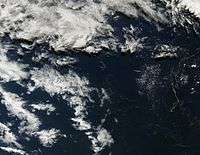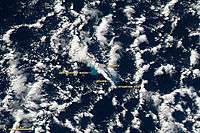2012 Kermadec Islands eruption
| 2012 Kermadec Islands eruption | |
|---|---|
|
NASA image of Havre Seamount eruption and initial formation of pumice raft | |
| Volcano | Havre Seamount |
| Date | 18–19 July 2012 |
| Time | morning |
| Type | Submarine |
| Location |
Kermadec Islands 31°07′13″S 179°58′07″W / 31.12028°S 179.96861°W |
The 2012 Kermadec Islands eruption was a major undersea volcanic eruption that was produced by the previously little-known Havre Seamount near the L'Esperance and L'Havre Rocks[1] in the Kermadec Islands of New Zealand.[2][3] The large volume of low density pumice produced by the eruption accumulated as a large area of floating pumice, a pumice raft, that was originally covering a surface of 400 square kilometres (150 square miles), spread to a continuous float of between 7,500 and 10,000 square miles (19,000 and 26,000 km2)[4][5] and within three month dispersed to an area of more than twice the size of New Zealand.[6]
The thickness of the raft may initially have been as high as 3.5 metres (11 feet) and was reduced to around 0.5 metres (1 foot 8 inches) within a month.
Three months after the eruption, the mass had dispersed into very dilute rafts and ribbons of floating pumice clasts. Most pumice clasts became waterlogged and sunk to the sea floor while some flocks have stranded in the Tonga islands, on the northern shores of New Zealand, and eventually on the eastern coast of Australia one year after the eruption.[7]
Eruption

The eruption of the Havre Seamount was not initially noticed by scientists, and volcanologists were not even aware that the Havre Seamount was an active submarine volcano.[2] After the pumice raft was detected, researchers retrospectively examined satellite imagery and past seismic activity in an attempt to pinpoint the time and location of the eruption that produced the pumice raft.[2] Seismologists discovered a cluster of earthquakes (ranging in magnitude between 3.0 and 4.8) that occurred 18–19 July 2012.[2][8] These earthquakes were consistent with magma rising into a magma chamber prior to eruption.[2] Analysis of satellite imagery showed an ash plume appear on 18 July 2012 and conclude several days later.[2][8] Although some volcanologists initially believed that the eruption might have occurred at the Monowai Seamount, this possibility was later ruled out.[8] It is also believed that the eruption was unrelated to the 2012 Te Māri eruption at New Zealand's Mount Tongariro.[9]
In 2015 a scientific expedition set out to study changes of seafloor topography in the area surrounding Havre Seamount. [6] The same group of researchers mapped the distribution of the floating pumice blocks driven by wind, ocean currents and eddies.[7]
Pumice raft

Scientists were not aware that any eruption had occurred until a huge pumice raft was sighted and photographed at 14:40 NZST 0n 31 July 2012 by Maggie de Grauw while on a commercial flight from Faleolo, Samoa to Auckland, New Zealand. She emailed her pictures to Dr Scott Bryan, Senior Research Fellow at Queensland University of Technology. After discussion it was ascertained that the raft was around 1,000 kilometres (620 miles) north of Auckland. Dr Bryan then contacted Olivier Hyvernaud from the Laboratoire de Géophysique, Tahiti, who confirmed the location from Terra/MODIS imagery from NASA. The raft was subsequently sighted by members of the New Zealand Defence Force on 9 August 2012[10]—several weeks after the eruption had occurred.[2] It was spotted by an Orion aircraft and then approached and sampled by the strategic sealift ship HMNZS Canterbury.[8] The pumice raft measured approximately 300 miles (480 km) in length and more than 30 miles (48 km) in width, making the floating island larger in surface area than Israel.[9][10] An officer in the Royal Australian Navy was quoted as saying that it was "the weirdest thing [he had] seen in 18 years at sea".[9][10]
References
- ↑ Science Direct map of Kermadec Islands and Seamounts
- 1 2 3 4 5 6 7 Klemetti, Erik (13 August 2012). "Havre Seamount: The Source of Kermadec Island Pumice Raft?". Wired. Retrieved 13 August 2012.
- ↑ Bryner, Jeanna (14 August 2012). "'Raft' in Pacific Found, NASA Says". Live Science. Retrieved 14 August 2012.
- ↑ Memmott, Mark (10 August 2012). "7,500 Square Miles Of Pumice Floating In Pacific Is 'Weirdest Thing I've Seen'". NPR. Retrieved 13 August 2012.
- ↑ AP (10 August 2012). "Massive Rock Raft Found Floating off New Zealand". ABCNews.com. Retrieved 13 August 2012.
- 1 2 Website of the expedition Mesh
- 1 2 Martin Jutzeler, Robert Marsh, Rebecca J. Carey, James D. L. White, Peter J. Talling, Leif Karlstrom, On the fate of pumice rafts formed during the 2012 Havre submarine eruption, journal Nature
- 1 2 3 4 Cooke, Michelle (11 August 2012). "Scientists rock theory on pumice raft". Stuff.co.nz. Retrieved 13 August 2012.
- 1 2 3 Gannon, Megan (10 August 2012). "Huge pumice rock 'island' seen floating in South Pacific: New Zealand's Royal Navy spots raft larger than Israel — but no one knows where it's from". NBCNews.com. Retrieved 13 August 2012.
- 1 2 3 Gannon, Megan (13 August 2012). "Mystery Rock Shelf Floating in Pacific: Floating pumice rocks are covering an area larger than Israel in the South Pacific.". Discovery News. Retrieved 13 August 2012.
